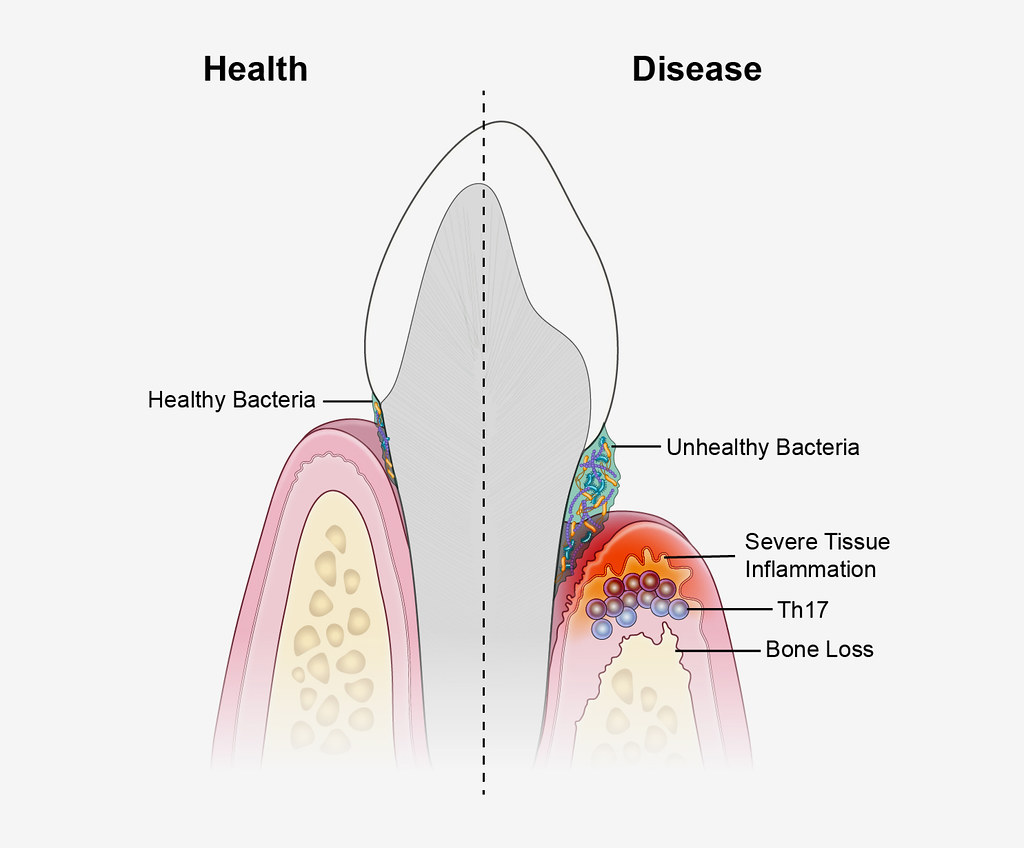types of gum disease, periodontal disease stages, gum disease treatment at home, periodontal disease treatment, periodontal disease definition, is periodontal disease reversible, types of gum infections, gum disease pictures
Gingivitis and Periodontal Disease is the term used when gums are inflamed because of the accumulation of deposits of plaque and bacteria. Untreated gingivitis will further turn into recession and bone loss is known as periodontitis which eventually leads to loss of teeth.
Gingivitis heals with maintaining good oral hygiene, Daily twice brushing, flossing of your teeth use of mouthwash and ultrasonic cleaning by going every twice in a year to your dentist.
Redness or bleeding of gums while brushing are the symptoms of gingivitis which causes halitosis or bad breath in the mouth and creates deep pockets and swelling in your gums. This indicates the need for deep cleaning which will remove the plaque and tartar from surfaces of teeth and later sterilize the gums with red laser light which does not require any stitches. The laser uses heat to strip away the diseased gums leaving healthy tissue in place.

TYPES OF GUM DISEASE
Gingivitis if left untreated can advance to periodontitis which will lead to tooth loss and other health problems.
The most common symptoms of gingivitis are red and swollen gums that bleed easily.
Factors contributing to cause gingivitis and gum disease:
- Diabetes
- smoking
- aging
- genetic
- systemic diseases
- conditions like stress, inadequate nutrition, pregnancy, HIV infection
- certain medication use
With time, plaque that is present on tooth surfaces persists growing below the gum line.
Gums are separated from the teeth, were pockets (spaces between the teeth and gums) are formed which are infected. The pockets deepen and more gum tissue and bone are destroyed as the disease progresses. Often, this destructive process has very mild symptoms. Often, periodontitis progresses without symptoms. It causes an infection that burrows deeper into the periodontal tissue, destroying the tissue that keeps the tooth attached to the jaw bone. The body defends itself against the bacterial attack by destroying the bone and eventually, the tooth may come off. If the teeth start to feel loose, it is often too late.
This is why it is important to diagnose the disease at an early stage. It is important to diagnose the disease as early as possible, but not all patients are as likely to catch the disease. There are many forms of periodontitis.
The most common ones include the following:
Aggressive periodontitis occurs in patients with features including rapid loss of periodontal ligament attachments and bone destruction.
Chronic periodontitis shows signs such as inflammation within the supporting tissues of the teeth, progressive attachment, and bone loss. This is the most frequent cause of pocket formation and/or recession of the gingiva. It is more common in adults but can occur at any age.
Some common cause of gingivitis and gum disease:
These bacteria, along with mucus forms a sticky, colorless called plaque on teeth. Brushing and flossing help get rid of plaque. If plaque is not removed it forms calculus called tartar which is hard and cannot remove by normal brushing. It is possible to remove only by a dentist with ultrasonic cleaning.
Smoking is the most significant factor among various risk factors. Other risk factors include diabetes; hormonal changes, pregnancy, medications, etc.
Symptoms of gingival and periodontal diseases include:
• Bad breath
• Red or swollen gums
• Tender or bleeding gum
• Painful chewing
• Loose tooth
• Sensitive teeth
• Receding gums or longer appearing teeth
Diagnosis for Gingivitis and Periodontal Disease (Gum Disease)
At a dental visit, a dentist or dental hygienist will:
• Check your gums for any signs of inflammation.
• They will use a fine instrument “probe” to check for pockets and measure them around the teeth. This test for checking the pocket depth is usually painless.
The dental professional may also:
• Take an x-ray to check if any bone loss.
• Refer you to a periodontist. Periodontists are specialized doctors for the treatment of gum disease and may provide you with treatment options that are not offered by your dentist.
Treatment for Gingival and Periodontal diseases-
The goal of treatment is to control the infection and achieve healthy gums. The type of treatment will depend on the extension of the gum disease. The dentist will suggest changing certain behaviors, such as quitting smoking, as a way to improve your treatment results. Gingivitis is easier to cure than periodontitis.
The treatment includes regular tartar removal either by a dentist or a dental hygienist. In severe cases of periodontitis, antibiotics may or may not be needed during surgery. Sometimes, the occlusion may need to be corrected in order to prevent further stress on the tissue caused by misaligned teeth. Proper self-care is an integral part of both gingivitis and periodontitis treatment: teeth, gum lines and areas between the teeth must be cleaned regularly and carefully.
Teeth must be brushed in the morning and in the evening. In addition to a toothbrush, you need an interdental brush or floss to remove the plaque from between the teeth. If brush or floss to remove the plaque from between the teeth. If your gums bleed, don’t stop cleaning them. Tartar that builds on teeth surfaces and exposes the gums to gingivitis cannot be removed at home. A dental hygienist can remove tartar with an ultrasonic scaler or manually.
Helpful Tips
Keep your teeth healthy by:
• Brush your teeth twice daily
• Flossing your teeth regularly to remove plaque from between teeth.
• Visiting the dentist for a professional dental cleaning every 6 months.
• Quitting smoking.
